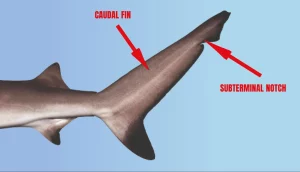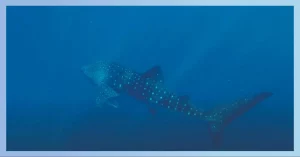Sharks can’t swim backwards due to the structure of their fins and the placement of their gills. Sharks are incredibly agile and powerful swimmers, but one thing they can’t do is swim backwards.
This is because of the unique design of their fins and the position of their gills. Unlike fish, whose pectoral fins allow for precise movement in any direction, the structure of a shark’s pectoral fins restricts their ability to move backwards.
Additionally, sharks have a spiracle behind their eyes that is used to draw water in when they are resting on the ocean floor, which prevents them from efficiently swimming in reverse. Consequently, sharks are specialized for forward movement and rapid turns, but backward swimming is not in their repertoire.
The Anatomical Structure Of Sharks
Sharks have unique anatomical structure that sets them apart from other fish. These adaptations enable them to thrive in their ocean habitat.

In this section, we will explore the key aspects of their anatomy that contribute to their inability to swim backwards.
The Unique Body Shape Of Sharks
Sharks have a streamlined and tapered body shape, which is designed for efficient and speedy movement through the water. Here are some important features of their body shape:
- Fusiform body: Sharks possess a fusiform body shape, characterized by a cylindrical body that tapers towards the head and tail. This streamlined design minimizes water resistance and allows them to navigate swiftly through the ocean.
- Dorsal fin: The prominent dorsal fin plays a crucial role in maintaining stability and balance during swimming. It prevents excessive rolling and allows sharks to swim straight effortlessly.
- Caudal fin: The large, crescent-shaped caudal fin, also known as the tail fin, is a powerful propeller that generates forward thrust. This enables sharks to propel themselves forward with remarkable speed.
The Role Of The Pectoral Fins In Their Movement
Sharks’ pectoral fins, located on either side of their bodies, are responsible for the control and maneuverability of their movements. Let’s delve into the significance of these fins:
- Lift and steering: The pectoral fins act as wings that provide lift, allowing sharks to glide through the water. They also play a vital role in steering, enabling sharks to navigate with precision.
- Agility: These fins are flexible and can be manipulated independently. This agility allows sharks to make sharp turns and sudden changes in direction, aiding in hunting and evading predators.
How The Placement Of The Gills Affects Their Swimming Ability
The placement of a shark’s gills is another factor that impacts their swimming ability. Here’s why:
- Forward-facing gills: Unlike most fish, sharks’ gills are positioned on the sides of their heads, facing forward. This arrangement allows them to extract oxygenated water efficiently when they swim, maintaining a constant flow of oxygen to their gills.
- Limited respiratory efficiency: While the forward-facing gills are advantageous for a steady oxygen supply, they create challenges for backward swimming. Sharks rely on forward movement to ensure a continuous flow of oxygenated water over their gills. Swimming in reverse would disrupt this flow, hampering their respiratory efficiency.
The Functionality Of Shark Tails
One remarkable aspect of their anatomy is their tail, which plays a vital role in their locomotion and overall swimming ability. Let’s explore the functionality of shark tails and how they contribute to the shark’s impressive maneuverability.

The Different Types Of Shark Tails And Their Purposes
Sharks have a variety of tail shapes depending on their species and habitat. Here are some common types of shark tails and their purposes:
- Lunate tails: These tails have a crescent shape, with the top lobe being larger than the bottom. Lunate tails are found in fast-swimming species like the great white shark and are designed for speed and efficient propulsion through the water. The shape allows them to generate powerful forward thrust, enabling them to pursue prey swiftly.
- Heterocercal tails: The heterocercal tail is distinctive, with the upper lobe being longer than the lower lobe. Sharks such as the thresher shark possess heterocercal tails, which provide them with lift and stability. The longer upper lobe acts like a wing, counterbalancing the shark’s heavy body and allowing it to adjust its depth effortlessly.
- Rounded tails: Rounded tails, also known as rounded caudal fins, are commonly found in bottom-dwelling sharks like the nurse shark. These tails lack the distinct upper and lower lobes, providing the sharks with more maneuverability in confined spaces and enabling them to navigate coral reefs or rocky environments.
- Triangular tails: Triangular tails, such as those found in the lemon shark, have a straightforward design with both lobes being almost equal in size. This tail shape offers a balance between speed and agility, making it suitable for sharks that need to navigate both open waters and more challenging environments.
How The Shape And Flexibility Of The Tail Impacts Their Movement
The shape and flexibility of a shark’s tail have a significant impact on its movement in the water. Here’s how:
- Streamlined shape: The tapered shape of a shark’s tail minimizes drag, allowing water to flow smoothly over it. This streamlined design reduces resistance, enabling sharks to swim efficiently and conserve energy.
- Flexibility: The tail is not a rigid structure but rather consists of cartilage and muscle, providing flexibility and allowing for different swimming techniques. Sharks can flex and move their tails from side to side or up and down, providing them with precise control over their movements.
- Enhanced maneuverability: Sharks with more flexible tails, like the hammerhead shark, have increased maneuverability. Their ability to change direction quickly and make tight turns is beneficial when navigating complex underwater environments or when pursuing agile prey.
The Role Of The Tail In Generating Thrust For Forward Swimming
The tail plays a crucial role in generating thrust for a shark’s forward swimming. Here’s how it works:
- Lateral movements: Sharks generate thrust by rapidly sweeping their tails from side to side. The muscles in their tails contract and relax, propelling water in the opposite direction and propelling the shark forward.
- Dorsal fin assistance: The movement of the tail also influences the positioning and function of the dorsal fin, which aids in stability and lift. By adjusting the angle of the dorsal fin, sharks further optimize their movement through the water.
- Efficient propulsion: The design of the tail, coupled with the rapid lateral movements, creates an efficient propulsion system for sharks. This method allows them to conserve energy while maintaining impressive swimming speeds, giving them an advantage when hunting or evading predators.
The Swimming Techniques Of Sharks
Sharks are ancient creatures that have inhabited the oceans for millions of years. These fascinating creatures have a unique swimming technique that sets them apart from other fish. In this section, we will explore the swimming techniques of sharks and delve into how they utilize their bodies to swim efficiently.

How Sharks Utilize Their Bodies To Swim Efficiently
- Streamlined body shape: The sleek and torpedo-like body shape of sharks allows them to cut through the water with minimal effort. Their bodies are tapered at the front, enabling them to slice through the water smoothly.
- Tail propulsion: The primary source of propulsion for sharks comes from their tail fins, also known as caudal fins. These fins are powerful and generate a side-to-side motion, propelling the sharks forward. By flexing their bodies from side to side, sharks create thrust and maintain their forward momentum.
- Muscular system: Sharks possess a robust muscular system that works in harmony with their streamlined bodies. Their muscles enable quick bursts of speed, allowing them to swim swiftly when hunting or evading predators.
The Importance Of The Lateral Line System In Their Navigation
- Detecting water movements: The lateral line system in sharks consists of a series of fluid-filled canals located on both sides of their body. These canals are equipped with sensory cells that can detect even the slightest vibrations and pressure changes in the water. This system enables sharks to perceive their surroundings, including the presence of prey or potential threats.
- Orientation and swim direction: Sharks utilize the lateral line system to orient themselves in the water and maintain a straight swimming path. The information gathered from the lateral line allows them to make adjustments to their swimming direction based on external stimuli like water currents and prey movements.
How Sharks Use Their Pectoral Fins For Maneuverability
- Efficient steering: The pectoral fins, located on either side of a shark’s body, act like wings, providing the necessary lift and control for precise movements. These fins are flexible, allowing the sharks to execute sharp turns, bank, and change direction swiftly.
- Responding to hydrodynamic forces: As the shark moves through the water, the flow of water pushes against its pectoral fins. This hydrodynamic force enables the shark to adjust its position, maintain stability, and fine-tune its swimming movements.
The Evolutionary Reasons For Inability To Swim Backwards
Often associated with power and ferocity, these apex predators have evolved numerous physical characteristics that have allowed them to thrive in their marine habitats.
One such interesting trait is their inability to swim backwards. In this section, we will explore the evolutionary reasons behind this fascinating aspect of shark biology.
Insights Into The Evolutionary History Of Sharks
Sharks have been swimming in the earth’s oceans for over 450 million years, making them remarkably ancient creatures. Throughout their evolutionary journey, they have undergone significant changes, adapting to various environmental conditions. Anatomically, sharks possess a streamlined body shape that aids in their efficient forward movement. This shape maximizes their ability to move through the water, reducing drag and allowing them to reach impressive speeds.
Fossil records indicate that the earliest sharks had a flexible notochord, a precursor to the backbone found in modern vertebrates. This feature, combined with their muscular bodies and unique fin structure, contributed to their swimming prowess.
How Specific Adaptations Limit Their Ability To Swim Backwards
The physiological adaptations of sharks play a vital role in limiting their ability to swim in reverse. Several key factors contribute to this limitation:
- Fin structure: Sharks possess a large, crescent-shaped caudal fin, also known as the tail fin, which drives their forward propulsion. This specialized structure provides incredible thrust for chasing prey or escaping predators but hampers their ability to reverse their direction effectively.
- Pectoral and pelvic fins: These fins, located on the sides of sharks’ bodies, provide crucial stability and maneuverability. However, their design is optimized for forward movement, making it challenging for sharks to generate the same level of control when swimming backward.
- Lack of a swim bladder: Unlike bony fish, sharks lack a swim bladder, a gas-filled organ that helps regulate buoyancy. This absence decreases their ability to adjust their position in the water column, making it more challenging to reverse their direction.
The Advantages And Disadvantages Of This Evolutionary Trait
Advantages:
- Enhanced agility: While the inability to swim backward may seem like a disadvantage, sharks’ robust forward propulsion allows them to swiftly navigate their surroundings. This agility proves invaluable during hunting, as they can maintain their momentum and launch sudden attacks on prey.
- Efficient energetics: By focusing on forward movement, sharks conserve energy and optimize their hunting strategies. Their streamlined bodies and forward-oriented swimming prevent them from expending unnecessary effort on reversing their direction.
Disadvantages:
- Limited escape options: In situations where retreating is a necessity, the inability to swim backward may pose challenges for sharks. Faced with imminent threats, they may struggle to quickly change their trajectory and escape predators.
- Impeded feeding efficiency: Swallowing prey headfirst is more efficient for sharks, as this allows them to take advantage of their streamlined form and reduce water resistance. However, when feeding on larger prey, they might have difficulty reversing their position for optimal swallowing.
Common Misconceptions About Sharks And Swimming
Contrary to popular belief, sharks are not capable of swimming backwards. This misconception has been perpetuated by various sources, including movies and media portrayals. However, it is important to separate fact from fiction when it comes to understanding the swimming abilities of these ancient predators.
Here are some key points to consider:
- Sharks lack the physical structure necessary for backward swimming. Their bodies are streamlined and designed for efficient forward motion through the water. The shape of their fins, specifically the lack of a rear-facing caudal fin, prevents them from propelling themselves in reverse.
- While sharks can certainly change direction or slow down their forward motion, they do so by adjusting the angle of their pectoral fins and generating lateral movements. This allows them to maneuver in tight spaces or execute quick turns, but it does not enable them to swim in reverse.
- The misconception of sharks swimming backwards may stem from confusion with certain species of fish that possess the ability to move in a reverse direction. However, sharks and fish belong to different evolutionary lineages and have distinct anatomical features.
Exploring Misconceptions Regarding Shark Behavior And Anatomy
Sharks have long been the subject of myths and misconceptions, often due to sensationalized media portrayals. It is essential to separate fact from fiction when it comes to understanding these apex predators. Here are some key points to address common misconceptions:
- Sharks are not mindless killing machines. They play a vital role in maintaining the health and balance of marine ecosystems. While they are apex predators, their behavior is not driven solely by the desire to attack or consume humans.
- Shark attacks on humans are extremely rare. The chances of encountering a shark while swimming in the ocean are incredibly slim, and even rarer is the likelihood of being attacked. In fact, humans pose a much greater threat to sharks than the other way around.
- Sharks have an incredible diversity of species, each with its own unique characteristics and behaviors. Some species, like the aggressive great white shark, have received significant media attention, contributing to the misconception that all sharks are dangerous. However, the majority of shark species are not a threat to humans.
The Impact Of Media Portrayals On Misconceptions About Sharks
Media portrayals of sharks, particularly in movies and documentaries, have played a significant role in shaping public perception and perpetuating misconceptions. Here are some key points to consider regarding the impact of media on our understanding of sharks:
- Movies like “jaws” have played a major role in fostering a fear of sharks among the general public. While these films may be entertaining, they often exaggerate shark behavior and create a distorted image of these fascinating creatures.
- Documentaries focused on shark attacks or sensationalizing their hunting behavior can further reinforce misconceptions about sharks. These programs tend to highlight rare and dramatic events, creating an inaccurate representation of the species as a whole.
- It is crucial to approach media portrayals of sharks with skepticism and seek out reliable sources of information. Scientific research and reputable conservation organizations provide a more accurate understanding of shark behavior and the important role they play in our oceans.
Other Fascinating Shark Facts
Sharks have captivated our curiosity for centuries. From their unique appearance to their impressive swimming abilities, there’s so much to learn about these majestic predators. In this section, we will explore the diversities among shark species and their swimming capabilities, as well as the unique features and adaptations that have contributed to their survival.

Diversities Among Shark Species And Swimming Capabilities
Sharks come in a wide variety of species, each with its own distinctive characteristics. Some species, like the great white shark, are known for their incredible size and power, while others, such as the dwarf lanternshark, are much smaller and more elusive.
Each species of shark has different swimming capabilities that are suited to their specific needs and habitats. For example, the mako shark is known for its remarkable speed, reaching up to 45 miles per hour, making it one of the fastest swimming sharks in the ocean. On the other hand, bottom-dwelling sharks like the nurse shark have adapted to have a slow and steady swimming style, allowing them to conserve energy as they navigate the ocean floor.
Unique Features That Contribute To Sharks’ Swimming Abilities
Sharks have a streamlined and hydrodynamic body shape, which reduces water resistance and allows them to move through the water with ease. Their bodies are designed to minimize drag, enabling them to swim efficiently and swiftly.
Another unique feature that aids in their swimming abilities is their powerful tail fin, also known as the caudal fin. This fin provides the main propulsion for their movements, allowing them to generate speed and maneuverability underwater.
Sharks also possess a unique type of cartilage skeleton, which is lighter and more flexible than the bony skeletons found in most other fish. This lightweight structure provides greater agility and allows them to move and twist their bodies with precision.
Interesting Adaptations Sharks Have Developed For Survival
One of the most fascinating adaptations of sharks is their ability to sense prey using electroreception. Specialized organs called ampullae of lorenzini detect weak electrical fields produced by other animals, enabling sharks to locate potential food sources even in low visibility conditions.
Many shark species have multiple rows of teeth that are constantly replaced throughout their lives. This adaptation ensures they always have sharp and functional teeth for hunting and feeding.
Sharks also possess unique adaptations to survive in different environments. Some species, like the goblin shark, have an extendable jaw that allows them to catch prey at a distance, while others, like the carpet shark, have elaborate camouflage patterns that help them blend into their surroundings and ambush unsuspecting prey.
Frequently Asked Questions
Do Sharks Have Bones?
No, sharks do not have bones. They have a cartilaginous skeleton which is lighter and more flexible.
Can Sharks Breathe Out Of Water?
Sharks rely on their gills to extract oxygen from water, so they can only breathe underwater.
How Fast Can Sharks Swim?
Sharks are incredibly fast swimmers, with some species reaching speeds of up to 60 miles per hour.
Are Sharks Color-Blind?
No, sharks can perceive colors. They have color vision that helps them navigate their surroundings and detect prey.
Conclusion
To sum it up, the question of why sharks can’t swim backwards is a fascinating one. We’ve explored the anatomical reasons behind this phenomenon, such as the placement of their fins and the structure of their muscles. We’ve also discussed how their hunting techniques and streamlined bodies are optimized for forward movement.
Despite their incredible adaptations and evolutionary success, sharks are limited in their ability to swim in reverse. This limitation may actually be a strength, allowing them to focus on moving effortlessly through their marine habitats and maintaining their predatory dominance.
Understanding the reasons behind this unique characteristic not only sheds light on the incredible diversity of the animal kingdom, but also highlights the intricate interconnectedness of form and function in nature. So the next time you encounter a shark gracefully gliding through the water, take a moment to appreciate the wonders of their forward-facing design.





